An annotated history of James Cowan
Last month I wrote about the new Cowan family papers that I had begun processing here at the Library. As I mentioned last time, I am starting on James Cowan’s personal library of books, which he used as a kind of filing system. Most of these books have loose papers folded into them, including letters, clippings, drafts, and photographs. I am currently going through each book, taking out the loose material which I flatten and house with the book, and putting both into acid-free enclosures.
When creating the associated descriptive records I assign a series to each folder, then summarise its contents, adding basic details such as dates, names, subjects, etc. As I delve deeper into the processing of these materials, I am finding so many interesting new things, and trying to reflect this in the records I create. This blog is the second entry in what will be a series of blogs about the arrangement & description process of this wonderful new addition to our library’s treasures.
A little green book
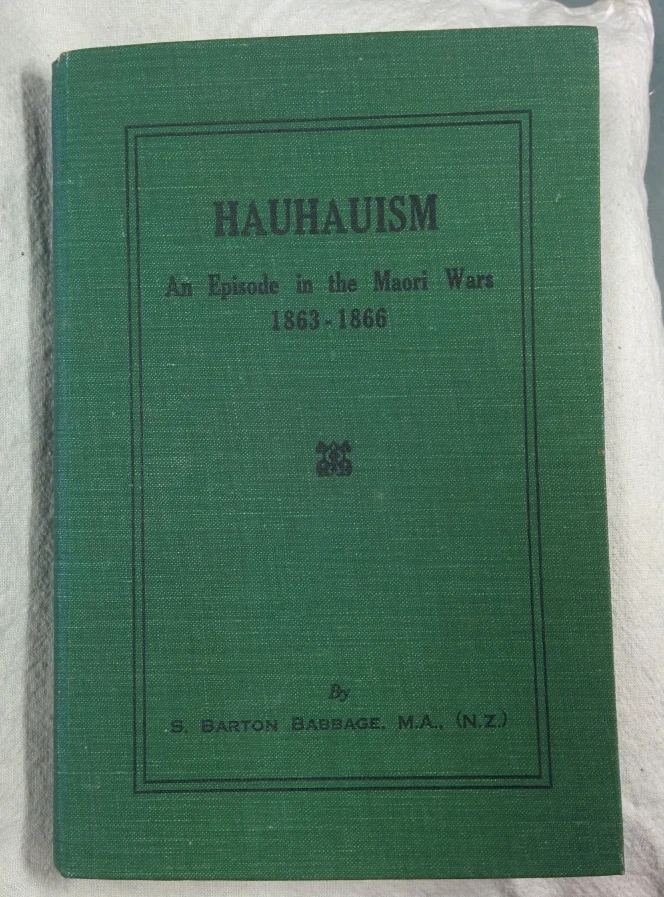
Hauhauism: An episode in the Maori Wars 1863-1866 by S Barton Babbage, MA (NZ)
This time I am going to highlight just one item, which although small, holds some fascinating insights into James Cowan’s character, including his intolerance of bad scholarship, and the value he placed on defending his own reputation. The item is a little green book called Hauhauism: An episode in the Maori Wars 1863-1866 by S Barton Babbage, MA (NZ). According to the online Maori Dictionary, "Hauhau was a movement founded in Taranaki in 1862 by Te Ua Haumēne in response to Pākehā confiscation of Māori land and led to the establishment of the Pai Mārire Christian faith". The book was published in 1937 by A H & A W Reed. This was a topic James Cowan had written about previously in his two volume history, The New Zealand Wars, so he had been sent a copy of Babbage’s book to review.
When I opened the book, I noticed some annotations, written in ink, by James Cowan, as well as a collection of letters folded up in it.
Here on page 43, Cowan writes in the margin beside a footnote the author had written about his (Cowan’s) descriptions of the Moutoa Battle. Babbage alleges these descriptions were drawn from Cowan’s "fertile imagination" and that he "gives no authority or justification of his statements". Cowan's written response is to the point: "author is a darn liar – see my History Vol 2, pp 31, 32, 33".
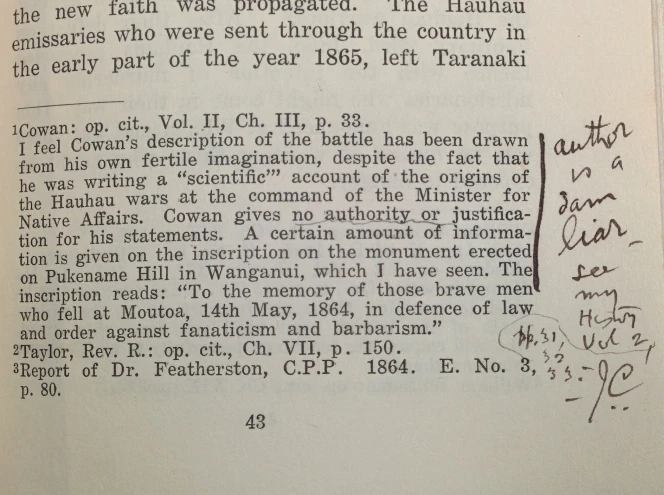
The offending page, with Cowan’s annotations
The papers also include a copy of a letter that Cowan wrote to the book’s publisher, dated 7 November 1937. It becomes clear in this letter that Cowan had been sent the Hauhauism book to review, and is not too impressed with the aspersions cast upon him in the offending footnote.
There is a passage which is a direct charge against my honour & credibility as a historian. It charges me with having drawn my descriptions of the battle of Moutoa Is 1864, from my “fertile imagination” & alleges that I gave “no authority or justifications” for my statements.
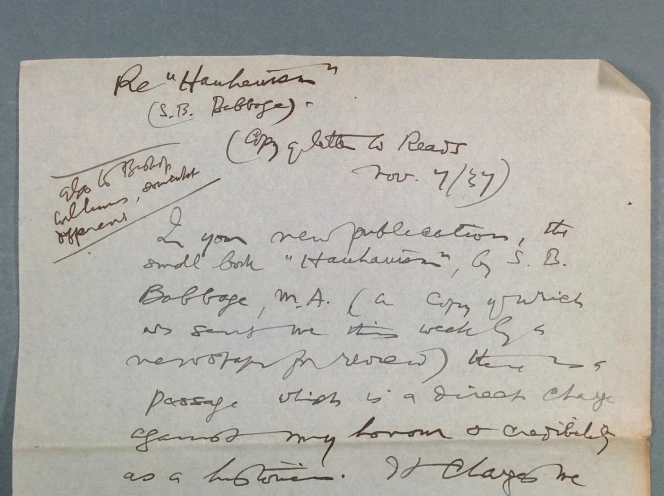
Cowan’s letter of complaint, dated 7 November 1937. Ref: MS-Papers-11946-008
He goes on to say that this note by Babbage "is not only impertinent but is a lie". Cowan then clarifies the part of his New Zealand Wars book that relates to the Moutoa battle, and details his research process saying it's "written from the direct statements made to me by several participants in the battle, including both Hauhaus and 'friendlies' numbering about a dozen altogether". He states that one of his informants was involved in the hauhau rites before and during the battle, and gives the page numbers relevant for what Babbage had alleged came from Cowan’s "fertile imagination". He also talks about a biographical sketch of this informant which he had included on page 30 of his New Zealand Wars volume 2, which was his authority for this account.
In his letter to Reed, Cowan then requests that the book is withdrawn from sale immediately, or alternatively, that "page 43 be cut out before any copies are sold or otherwise distributed" and that "those out already for sale should be recalled".
There are a series of six letters of response to Cowan from A H and A W Reed, written between 12 November and 8 December 1937. They treat Cowan’s complaint very seriously, and initially write to say that Mr Babbage was in England, but that his father may be able to act for him. On the 17 November, they write again to say that after hearing from Mr Babbage, Senior, they were "holding over the distribution of the book until the matter has been adjusted".
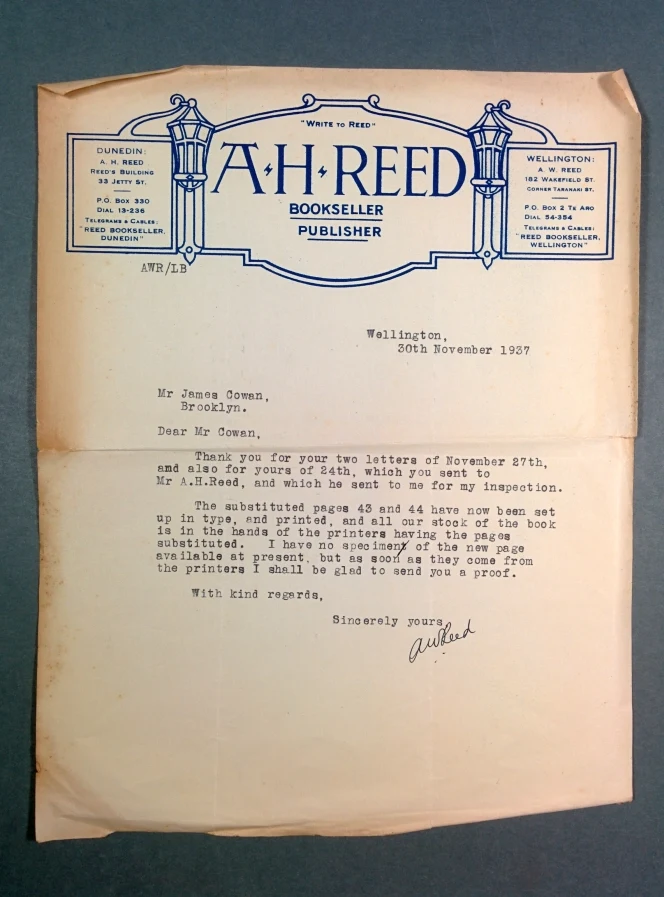
Letter from Reed outlining the action they have taken in response to Cowen
Tito!
The papers also contain a letter that Cowan wrote to Reed on 27 November, in relation to a different reference to Cowan on page 75 of Hauhauism.
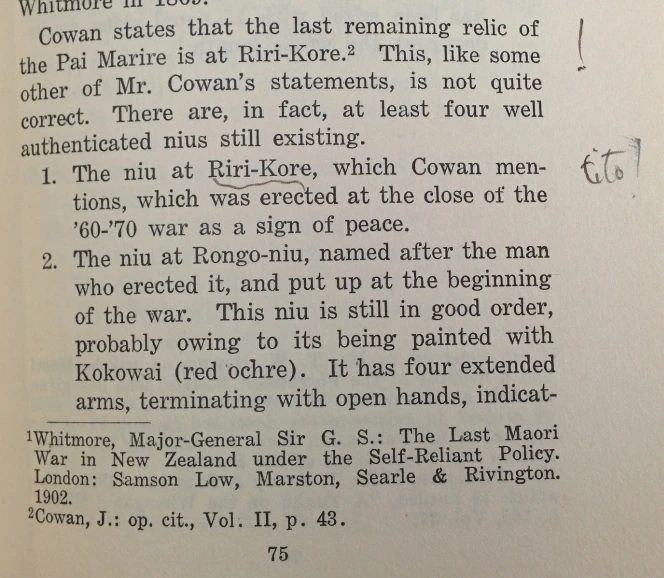
Page 75 of Hauhauism, with Cowan’s annotation
On this page of the book Cowan writes the word "tito!" which basically translates as ‘made up’ or a ‘falsehood’ – corresponding to a passage in the book about the location of a niu pole (associated with the Pai Mārire faith). The author alleges that Cowan had said that the last remaining niu was located at "Riri-Kore", and that he was wrong as there were "at least four well authenticated nius still existing". In his 27 November letter to Reed, Cowan says that he never mentioned a niu at Ririkore, but had written about a niu at Maraekowhai, that he had personally seen in 1903, and that was photographed by Sir Maui Pomare (then Dr) in 1905.
There are further letters on the issue of the niu (as well as other matters), by others, and also a letter to Cowan from Bishop Herbert Williams (dated 29 November 1937) who had written a short foreword for Hauhauism. The bishop’s response says that he had not intended to support any attack upon Cowan, and that he was very busy at the time when he read the manuscript, and "may have missed a page or more".
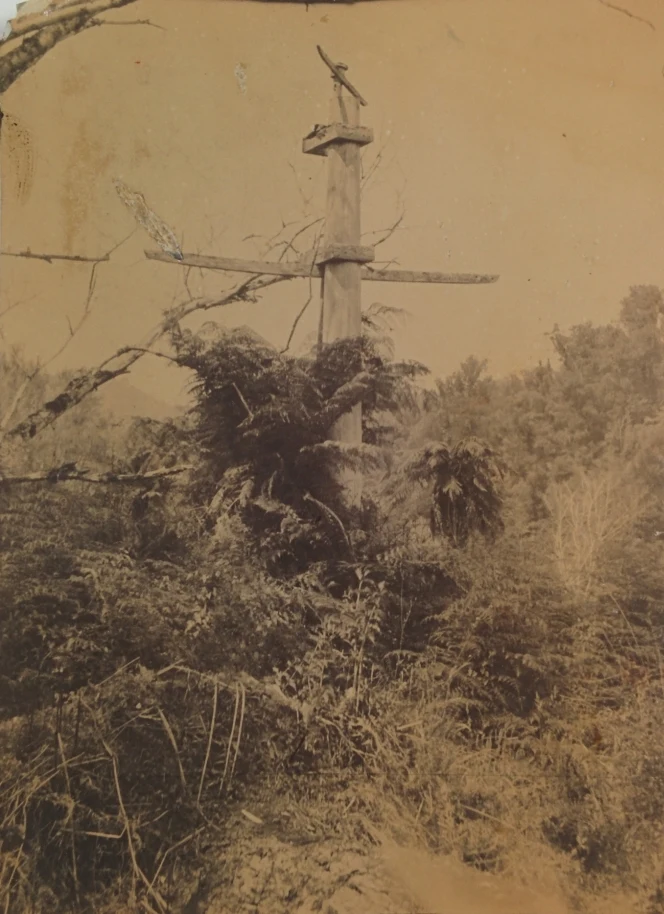
Lower mast and lower yard of Pai Marire Niu pole. Photograph taken at Maraekowhai, on the upper reaches of the Whanganui River, in 1905 by Sir Maui Pomare. Ref: PAColl-9843
Mystery name
Included in these other letters I found a letter from someone who was clearly Bishop Williams’ son or daughter (dated 20 December 1937), who was writing to Cowan after the death of their father, just a few weeks after Cowan had last corresponded with him on the topic of the book.
When I was creating the record for this book and folder of letters, I couldn’t quite read the first name of the correspondent, but I could see that it ended with ‘la’. This made me think it was probably a female name, but I had trouble finding any reference to Bishop Williams’ children’s names in any of the online biographies about him. Eventually I saw that there was a book called Faith and Farming: Te Huarahi ki te Ora about the Williams Family, in the National Library catalogue for published items. I ordered up the 1998 revised edition of the book at once from the catalogue.
It contains a lot of genealogical information of the families of the two Williams brothers, Henry and William Williams, who were leading missionaries with the Church Missionary Society (CMS) in New Zealand from the 1820s. The second edition of the book contains a picture of Herbert Williams and his children, and a section detailing his children’s names and biographies, including a daughter, Ursula, with her birth and death dates of 1891 and 1960.
It is always quite exciting to find such information that was previously unknown. I was able to add her full name to the folder’s record allowing us to create a fuller context for our descriptions, including, in this case a brand new name record for Ursula!
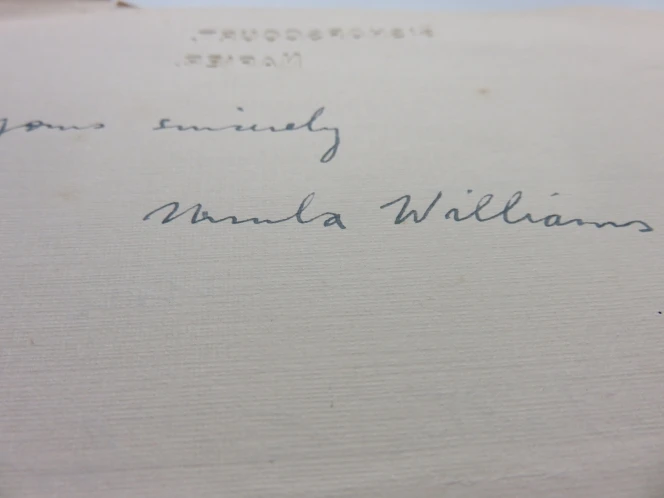
The mystery signature turned out to be Ursula Williams'
Typos and footnotes
The book and letters that were in the original box of papers, are now safely stored in a folder with the reference number MS-Papers-11946-008. Also contained in the folder is a copy of the corrected page 43 of the Hauhauism book, which includes annotations by Cowan, saying he had received it on 3 December 1937. He still manages to notice a typo in the corrected footnote which misspells the name of the hill below which the Moutoa monument stands, which is spelt as ‘Pukename’ Hill. Cowan strikes through the ‘e’ and writes a ‘u’ in the margin, to correct the name to ‘Pukenamu’.
I really like the way Cowan’s annotations and his letters reflect his character. I can tell he was meticulous and liked words to be spelt correctly (he would have made a great Arrangement & Description librarian!). He also felt proper acknowledgement was his due, and that he guarded his reputation as a historian.
He was around 67 years old at the time of this episode, and had achieved much of his life’s work (he died just seven years later). Similarly to the book I wrote about last time, The Little History of New Zealand, which he had annotated when he was just a teenager and new journalist, you could see that even at such an early stage in his career, he had already begun questioning the version of history that was being fed to him.
This book and the papers folded into it, are further evidence that this new collection of Cowan family papers has many rich treasures to discover (once they become available, after I have finished the arrangement & description process). I hope you have enjoyed reading about another unique item which carries with it many stories relating to James Cowan’s values, and the importance of good scholarship, and accurate footnotes!

The corrected page 43 of Hauhauism, with Cowen's further correction
Greatly enjoyed reading this piece. Illuminating! Look forward to viewing future posts